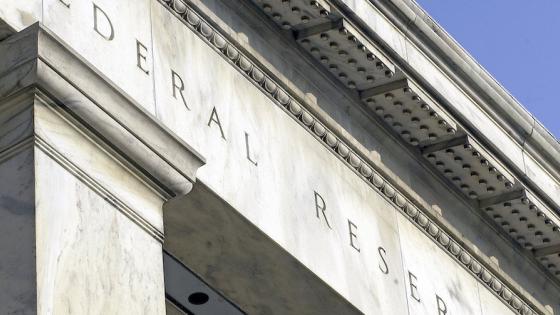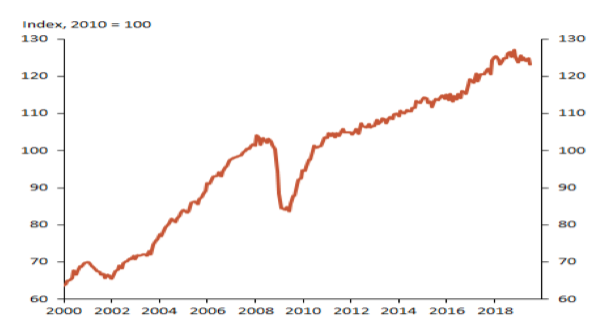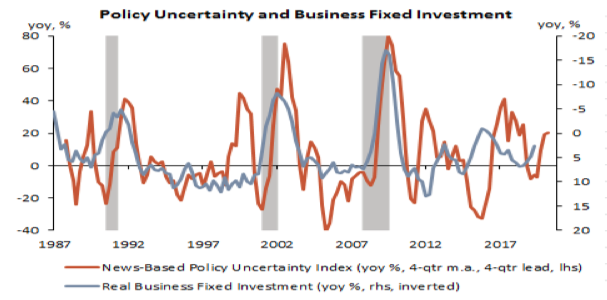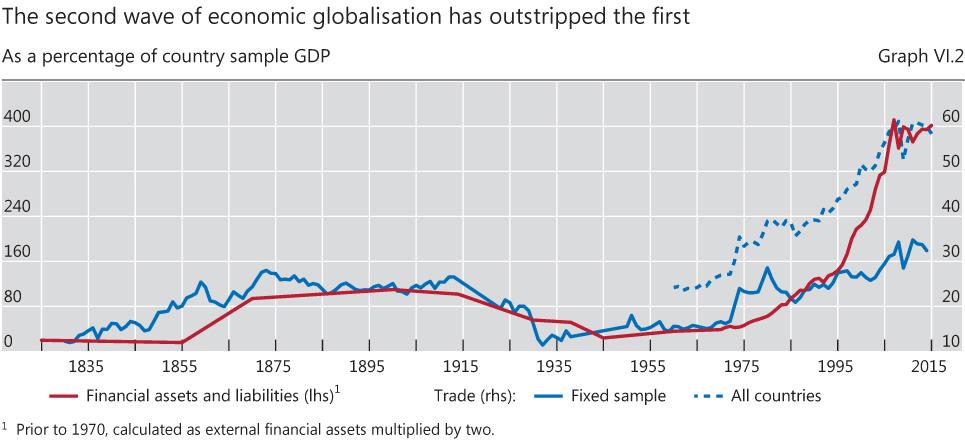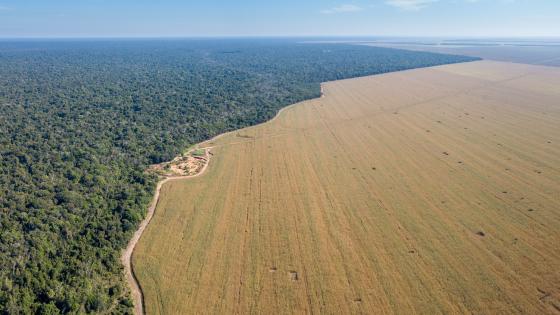President Trump’s objectives to force China to open access to its markets for international trade, reduce capital controls, modify unfair treatment of intellectual property, and address cybersecurity and other US national security issues are important goals with sizeable benefits. However, the escalating tariffs are having a mounting impact on global trade volumes, industrial production and capital formation (see Figure 1) (Bown and Irwin 2019, Cavallo et al. 2019, Irwin 2019), and the tactic of relying exclusively on barriers to trade and protectionism is misguided and potentially dangerous.
Figure 1 World trade volume
Source: Netherlands Bureau for Economic Policy Analysis
These policies put the Fed in a bind. Although the Fed has achieved its dual mandate, its discretionary approach to conducting policy has led it to cut its policy rate in response to perceived downside risks associated with trade policy uncertainties (Powell 2019). These insurance rate cuts will have little if any impact in offsetting the supply constraints on productive capacity imposed by the tariffs and related uncertainties (Levy 2019). However, by narrowing the buffer from the zero lower bound, the cuts will reduce the Fed’s flexibility to implement effective countercyclical policy in response to a future economic downturn, and adds distortions to the financial system. Combined with President Trump’s inappropriate public pressures on the Fed, the Fed’s heightened focus on uncertainties increases the risks of a policy mistake and undercuts its public credibility and independence (Bordo and Levy 2019).
President Trump’s reliance on tariffs fulfils his promise made during the 2016 presidential campaign. Tariffs are now imposed on over $275 billion of US imports, mostly from China, but also Japan, South Korea, Canada, and Mexico (Chudik 2019, Fajgelbaum et al. 2019), while the US’ trading partners have retaliated with approximately $121 billion in tariffs on US goods (Amiti et al. 2019). The erratic ratcheting up of tariffs and erratic threats of more to come seem to reflect President Trump’s miscalculation of China’s responses and the widening scope of the US-China negotiations into complex non-tariff issues that will be hard to resolve.
Recent research finds that policy-related uncertainties are having as big or a bigger negative impact on capital spending and economic performance than the actual tariffs. We find a 0.49 simple correlation between the economic uncertainty index developed by Baker et al. (2016) and US business fixed investment (Figure 2). Ahir et al. (2019) develop a World Trade Uncertainty (WTU) Index derived from the Economist Intelligence Unit (EIU) country reports and estimate that the jump in the WTU index beginning in 2017 through Q12019 reduces global growth by up to 0.75% in 2019. Ebeke and Siminitz (2018) develop a measure of trade uncertainty aggregated over the EU, US, China, and the UK based on text-mining techniques, and estimate that a one-standard deviation increase in the level of trade uncertainty reduces the investment-to GDP ratio in the euro area by 0.75% in the following five quarters. Researchers at the Federal Reserve Board develop different measures of trade policy uncertainty – one at a firm level and two aggregate indicators based on using newspaper coverage and data volatility on import tariffs – and estimate that the rise in trade policy uncertainty in 2017 and 2018 predicts a decline in aggregate investment of 1-2% (Caldara et al. 2019).
Figure 2 Policy uncertainty and US business fixed investment
Sources: Baker et al. (2016) and Berenberg Capital Markets.
Recent trends and widespread anecdotal evidence support these research findings. Global trade volumes and industrial production in advanced nations are declining, reducing productivity, and capital formation has flattened. China’s largest trading partners – Japan, South Korea and other Asian nations, and Germany – are feeling the brunt of the impacts. Distortions imposed on highly integrated global supply chains are difficult to measure, but no doubt sizeable (Economist 2019). Persistent reductions in business investment and the capital stock would lower productive capacity and potential growth (Handley and Limoa 2017).
Big risk: Is the second era of globalisation ending?
Although history never repeats itself, it often rhymes – which makes the recent thrust in trade and immigration policies worrisome. The world has experienced two eras of globalisation in the past two centuries (see Figure 3) (Bordo 2017). The first, from the mid-19th century until 1914, was fuelled by reduced barriers to trade, important technological innovations and heightened cross-border flows of immigration and capital, and boosted rapid economic growth and standards of living. Growth in trade far outpaced national income and there was a significant European convergence of cross-border prices of tradeable goods (Findlay and O’Rourke 2004). Financial market integration facilitated the growth (Goetzmann 2016) and capital flows from European developed nations helped spur growth in emerging nations (Bordo 2002). Adherence by major nations to gold convertibility ensured stable exchange rates and acted as a commitment mechanism or a “good housekeeping seal of approval” for countries seeking access to the London capital market (Bordo and Rockoff 1996).
Figure 3 The wave of globalisation
Note: 1 Prior to 1970, calculated as external financial assets multiplied by two.
Source: BIS Annual Economic Report 87th Annual Report, 2016/17, Chapter 6, Page 100
But populist responses to mass immigration and global trade in the late 19th century led to a backlash of anti-immigration laws and trade barriers. The first era of globalisation culminated with the eruption of WWI in 1914 and the imposition of exchange and capital controls (Eichengreen 1992), along with tariffs and quotas. During the interwar period, the US was the worst offender, with the Fordney McCumber Act of 1922 and the Smoot Hawley Tariff of 1930. Other countries retaliated, and these barriers greatly accentuated the Great Depression (Crucini and Kahn 1996, 2003). The second era of globalisation since WWII has involved significantly reduced barriers to trade, immigration, and capital, the emergence of China as a super economic power, and the development of global supply chains. These factors have contributed greatly to the free flows of goods, labour, capital, and technological innovations that have generated strong global growth.
While the rise in anti-immigration initiatives and President Trump’s escalating tariffs are worrisome, three differences in the current situation should mitigate the economic fallout. First, capital controls that dominated the interwar period have not yet been imposed, and are highly unlikely. Second, advanced nations’ economies have dramatically reduced their reliance on manufacturing towards consumption and services, so that the burdens of tariffs on manufacturing will fall largely on emerging countries. Third, production processes have been integrated globally through complex supply chains, multi-national companies, and the sharing of information (Baldwin 2016). But these could be at risk as the tariffs escalate. Moreover the tariffs imposed so far are a small fraction of those imposed in the 1930s, and policymakers today have a far deeper understanding of the costs of barriers to trade, immigration, and the flow of capital, and how to stabilise the economy with a broader array of policy tools that did not exist 80 years ago. Also, the heightened sophistication of financial markets and capital flows greatly reduces the likelihood of a 1930s-type disaster. Nevertheless, preventable policy errors must be avoided.
Tariffs and monetary policy
Tariffs and trade policy uncertainties add several dimensions of difficulty to the Federal Reserve’s conduct of monetary policy. The Fed has achieved its dual mandate, with the lowest unemployment rate in 50 years and inflation just below 2%. But it cut rates in both July and September because of trade policy-related uncertainties, even though the actual data clearly indicated that the economy was growing in line with the Fed’s forecast and along the Fed’s estimate of its potential path. This is a clear departure from data-dependent conduct of monetary policy (Clarida 2018) and also its historic approach of changing monetary policy in response to the actual economic impacts of non-monetary (fiscal) policy changes rather than in anticipation of pending policy initiatives. This moves the Fed further from any kind of systematic (rules-like) approach to monetary policy and toward discretion and hunches on uncertainties. This increases the probability of policy error, which may undercut the Fed’s credibility and independence.
A more fundamental factor is whether the erratic ratcheting up of tariffs lowers aggregate demand or productive capacity (supply) in the economy, and whether monetary policy can do anything about it. While monetary policy stimulus may offset slumps in aggregate demand, it is incapable of offsetting supply constraints on productive capacity, like tariffs and policy-related uncertainties that reduce the capital stock and distort global supply chains (Levy 2019). Persistent monetary ease in the face of supply constraints will not stimulate growth, but will have negative consequences, even if inflation stays low. It moves the Fed closer to the zero lower bound and the artificially low rates penalise savers and subsidise creditors, and generate many financial distortions.
In this strained environment, the Fed should make clear that escalating trade barriers and policy uncertainties that impose supply constraints on productive capacity are beyond the scope of monetary policy to remedy. It should be more systematic and guided by rules in its conduct of monetary policy, and rely on actual data rather than its hunches on uncertainties. It must also emphasise the importance of it being independent to conduct policy without political interference or pressure, and rebuff inappropriate pressures from the administration while maintaining its politically neutral stance.
Authors’ note: This column is based on a presentation to the Shadow Open Market Committee at the Manhattan Institute, New York, 27 September 2019.
References
Ahir, H, N Bloom, and D Furceri (2019), “Caution: Trade uncertainty is rising and can harm the global economy”, VoxEU.org, 4 July.
Amiti, M, S Redding, and D Weinstein (2019), “The Impact of the 2018 Trade War on U.S. Prices and Welfare”, CEPR Discussion Paper no. 13564.
Baker, S R, N Bloom, and S J Davis (2016), “Measuring Economic Policy Uncertainty”, The Quarterly Journal of Economics, 131 (4), 1593-1636.
Baldwin, R (2016) The Great Convergence, Cambridge: Harvard University Press.
BIS (2017), 87th Annual Economic Report, 2016/17, Chapter 6, “Understanding Globilization”.
Bordo, M (2017), “The Second Era of Globalization is Not Yet Over: An Historical Perspective”, NBER Working Paper no. 23786.
Bordo, M (2002), “The Globalization of Financial Markets: What Can History Teach Us?” in L Auernheimer (ed.), International Financial Markets, Chicago: University of Chicago Press.
Bordo, M, and M Levy (2019), “Tariffs and Monetary Policy: A Toxic Mix”, Shadow Open Market Committee, 27 September.
Bordo, M, and R Hugh (1996), “The Gold Standard as a “Good Housekeeping Seal of Approval”, Journal of Economic History, 56 (2), 389-428.
Bown, C, and D Irwin (2019), “Trump’s Assault on the Global Trading System”, Foreign Affairs, September/October.
Caldara, D, M Iacoviello, P Molligo, A Prestipino, and A Raffo (2019), “The Economic Effects of Trade Policy Uncertainty”, In manuscript presented at the 91st meeting of the Carnegie-Rochester-NYU Conference on Public Policy, held at New York University, April (12-13).
Cavallo, A, M Cal, and A Laski (2019), “The U.S.-China Trade War”, Harvard Business School Case 719-034, February. (Revised May 2019).
Chudik, A (2019), “President Trump’s Tariff Spree”, Federal Reserve Bank of Dallas, 7 June.
Clarida, R (2018), “Data Dependence and U.S. Monetary Policy”, The Bank Policy Institute Annual Conference, 27 November.
Crucini, M, and J Kahn (1996), “Tariffs and Economic Activity: Lessons from the Great Depression”, Journal of Monetary Economics 38, 427-467.
Crucini, M, and J Kahn (2003), “Tariffs and the Great Depression Revisited”, Federal Reserve Board of New York Staff Report no. 172.
Ebeke, C, and J Siminitz (2018), “Trade Uncertainty and Investment in the Euro Area”, IMF Working Paper WP/18/281, December.
The Economist (2019), “Special Report: Global Supply Chains”, July 11.
Eichengreen, B (1992), Golden Fettersa: The Gold Standard and the Great Depression, 1919-1939, New York: Oxford University Press.
Eichengreen B (2018), The Populist Temptation: Economic Grievance and Political Reaction in the Modern Era, New York: Oxford University Press.
Fajgelbaum, P, P Goldberg, P Kennedy, and A Khandelwal (2019), “The Return to Protectionism”, NBER Working Paper no. 25638.
Findlay, R, and K O’Rourke (2004), “Commodity Market Integration, 1500-2000”, in M Bordo, A Taylor, and J Williamson (eds.), Globalization in Historical Perspective, University of Chicago Press.
Goetzmann, W (2016), Money Changes Everything: How Finance Made Civilization Possible, Princeton University Press,
Handley, Km and N Limoa (2017), “Policy Uncertainty, Trade, and Welfare: Theory and Evidence for China and the United States”, American Economic Review, 107 (9).
Irwin, D (2019), “US Trade Policy in Historical Perspective”, NBER Working Paper no. 26256.
Levy, M (2019), “Monetary Policy Realities Facing the ECB, Fed and BoJ: More Easing Won’t Stimulate Economies”, Center for Financial Stability, July.
Powell, J (2019), “Challenges for Monetary Policy”, Federal Reserve Bank of Kansas City Jackson Hole Symposium, August.
